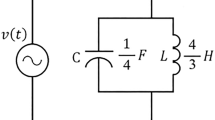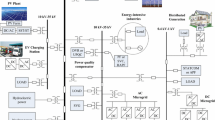Contents
The development of power theory of circuits with nonsinusoidal voltages and currents was shaped for several decades by two different approaches introduced, separately, by Budeanu and Fryze in the nineteen thirties. This paper investigates these two power theories from the present perspective and up to date comprehension of power phenomena in circuits with distorted voltages and currents. It shows the reasons for which Budeanu's power theory misinterprets power phenomena and why it does not provide fundamentals for the power factor improvement. This paper shows that a number of concepts introduced to power theory by Fryze are still alive and are very important for developing that theory, but it also has a number of serious limitations. Because of that, some issues, important theoretically, and a number of practical problems in systems with distorted waveforms were not solved within Fryze's power theory. This was the reason for further developing the power theory of systems with nonsinusoidal voltages and currents. This process is not completed yet and a lot can be learned from the history of this theory's development.
Übersicht
Die Entwicklung der Leistungstheorie für Stromkreise mit nichtsinusförmigen Spannungen und Strömen wurde mehrere Jahrzehnte von zwei verschiedenen Ansätzen beeinflußt, die Budeanu und Fryze unabhängig voneinander in den 1930ern einführten. Dieser Aufsatz untersucht beide Leistungstheorien aus heutiger Sicht und mit dem derzeitigen Verständnis der Leistungser scheinungen bei verzerrten Spannungen und Strömen. Er zeigt die Gründe für die Fehlinterpretation der Erscheinungen in Budeanus Leistungstheorie auf und gibt an, warum diese nicht zur Grundlage für eine Leistungsfaktorverbesserung dienen kann. Es wird weiter gezeigt, daß einige von Fryze in die Leistungstheorie eingeführte Konzepte für die Weiternentwicklung dieser Theorie von großer Wichtigkeit sind, aber auch ernsthafte Grenzen aufweisen. Deswegen konnten einige theoretisch wichtige Fragestellungen und einige praktische Probleme in Systemen mit verzerrten Zeitfunktionen mit der Leistungstheorie von Fryze nicht gelöst worden. Dies war der Grund für eine Weiterentwicklung der Leistungstheorie für Systeme mit nichtsinusförmigen Spannungen und Strömen. Dieser Vorgang ist noch nicht abgeschlossen, wobei aus der Geschichte dieser Theorieentwicklung noch viel zu lernen ist.
Similar content being viewed by others
References
Steinmetz ChP (1892) Findet eine Phasenverschiebung im Wechselstromlichtbogen statt? Elektrotechnische Zeitschrift, Heft 42: 567–568
Ganz AF (1906) The physical meaning of power factor. Journal of Franklin Institute, 429
Krijger LP (1923) Der Einfluss des Hg-Gleichrichters auf den Leistungsfaktor. ETZ, 41
Illovici MA (1925) Definition et mesure de la puissance et de l'energie reactives. Bull. Soc. Franc. Electriciens
Budeanu CI (1927) Puissances reactives et fictives. Institut Romain de l'Energie, Bucharest
Weber E (1929) Die elektrische Leistung in allgemeinen Wechselstromkreis. ETZ 1547
Emde F (1930) Entohmung. ETZ, 533
Fryze S (1931) Wirk-, Blind-und Scheinleistung in Elektrischen Stromkreisen mit nichtsinusoidalen, Verlauf von Strom und Spannung. In Polish: Przeglad Elektrotechniczny, no. 7: 193–203, no. 8: 225–234, no. 22: 673–676, In German: ETZ, no. 25, 26, and 29
DIN 40110 (1964) “Wechselstromgrößen” Entwurf September 1964
Milic M (1970) Integral representation of powers in periodic non-sinusoidal steady state and the concept of generalized powers. IEEE Trans. on Edu.: 107–109
Shepherd W, Zakikhani P Suggested definition of reactive power of nonsinusoidal systems. Proc. IEE, vol. 119, no. 9 1361–1362
Depenbrock M (1979) Wirk, und Blindleistung. ETG-Fachtagung “Blindleistung”, Aachen.
Kusters NL, Moore WJM (1980) On the definition of reactive power under nonsinusoidal conditions. IEEE Trans. Pow. Appl. Syst., vol. PAS-99: 1845–1854
Page C (1980) Reactive power in nonsinusoidal systems. IEEE Trans. on Instr. Measur., vol. IM-29, no. 4: 420–423
Czarnecki LS (1981) Measurement principle of reactive power meter for nonsinusoidal systems. IEEE Trans. on Instr. Meas., vol. IM-30, no. 3: 209–213
Nowomiejski Z (1987) Generalized theory of electric power. Archiv fü r Elektrotechnik (63): 177–182
Fisher HD (1982) Bemerkungen zu Leistungsbegriffen bei Strömen und Spannungen mit Oberschwingungen. Archiv für Elektrotechnik (64): 289–295
Czarnecki LS (1984) Considerations on the reactive power in nonsinusoidal situations. IEEE Trans. Instr. Measur., vol. IM-34: 399–404
Akagi H, Kanazawa Y, Nabae A (1984) Instantaneous reactive power compensators comprising switching devices without energy energy storage components. IEEE Trans. on Ind. Appl. IA-20
Czarnecki LS (1987) What is wrong with the Budeanu concept of reactive and distortion powers and why it should be abandoned. IEEE Trans. Instr. Measur., vol. IM-36, no. 3: 834–837
Czarnecki LS, Swietlicki T (1990) Powers in nonsinusoidal networks, their analysis, interpretation and measurement. IEEE Trans. Instr. Measur., vol. IM-39, no. 2: 340–345
IEEE Std 100-1992 (1992) The New IEEE Standard Dictionary of Electrical and Electronics Terms. Published by IEEE
Depenbrock M (1993) The FDB-method, a generalized applicable tool for analyzing power relations. IEEE Trans. on Power Delivery, vol. 8, no. 2: 381–387
Czarnecki LS (1994) Dynamic, power quality oriented approach to theory and compensation of asymmetrical systems under nonsinusoidal conditions. Europ. Trans. on Electric Power, ETEP, vol. 5: 347–358
Author information
Authors and Affiliations
Rights and permissions
About this article
Cite this article
Czarnecki, L.S. Budeanu and fryze: Two frameworks for interpreting power properties of circuits with nonsinusoidal voltages and currents. Electrical Engineering 80, 359–367 (1997). https://doi.org/10.1007/BF01232925
Received:
Issue Date:
DOI: https://doi.org/10.1007/BF01232925




